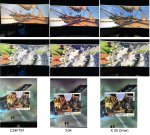A
Amusens
Gast
Finde dazu nicht auf Deutsch ???
Ergänzung ()
Ist es das?
Folge dem Video um zu sehen, wie unsere Website als Web-App auf dem Startbildschirm installiert werden kann.
Anmerkung: Diese Funktion ist in einigen Browsern möglicherweise nicht verfügbar.
Gamerock schrieb:Dennoch zeigt er an ein paar Übergängen schlieren, natürlich besser als die VA Panel mit ~25ms. Aber nach <10ms sieht mir das nicht aus.

Das oberste Bild ist das beste und das 6 Bit FRC Bild ist ein Qualitätsmängel.asus1889 schrieb:Wie sieht dieses Testbild bei euch aus ?
Beim X34A zeigt es kein Banding in Form eines 6 Bit FRC Panel. Absolut übergangsfrei, wie bei einem 10 Bit Panel, sind die Farbübergänge natürlich nicht:
6 Bit FRC Panel:
Anhang anzeigen 615851
Amusens schrieb:Das oberste Bild ist das beste und das 6 Bit FRC Bild ist ein Qualitätsmängel.
asus1889 schrieb:Marcus Hax0rway, teste es noch mal mit factory default settings.
asus1889 schrieb:Das kommt davon wenn man den Gammawert bei einem 8 Bit Panel falsch einstellt. Dadurch bekommt man zwar kräftigere Farben, hat aber dafür Banding ohne Ende.
Gamerock schrieb:Tatsächliches Bleeding davon ist unten über der Leiste und oben Rechts, unten Rechts ist Glow.
Anhang anzeigen 615709
We actually test using that Lagom gradient and have commented on it in the review. Refer to observations from Lagom in the contrast and brightness section. We did not see anything there or anywhere else in our testing that was at all unusual for an 8-bit VA panel. It is incorrect to assume that any banding visible would be down to the fact it is ‘6-bit + FRC’ when in fact 8-bit source material outputted correctly using 8-bits (FRC or otherwise) could still and often does still have a degree of banding. Users are also not used to seeing the level of detail that can be brought out in games etc. on a VA panel, especially in dark scenes, where inherent banding in the source material is visible due to the monitor displaying things correctly rather than it being masked by IPS glow or less obvious due to weak contrast.
The panel data sheet has no mention of dithering, AOC have confirmed multiple times that it is a true 8-bit panel (including their product manager who is in charge of the panels used for various products) and I have no reason to think (as above) from my testing that this is not the case. Furthermore, HP and manufacturers more broadly are prone to errors in their specifications, so they are not a reliable source.
P.S. They use variants of the same panel with different panel border thicknesses (hence obvious aesthetic differences). The curvature is actually exactly the same (even though AOC chooses to specify it differently to HP) as this is related to the panel itself and does not change between monitors or in this case very similar variants of the same panel. The panel curvature is probably some way between 1800R and 2000R in reality, for both models. Or perhaps varies slightly between units. AOC America actually quote 1800 – 2000R.

